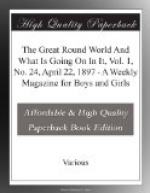I shall here limit myself to a brief description of the last.
Brass is made by melting together in large crucibles certain proportions of copper and zinc. The heat applied must be considerable, for during the fusion of the two metals a white flame from the zinc and a green one from the copper flash from the mouth of the crucible. When properly mixed the molten alloy is poured into rectangular or cylindrical moulds. After cooling, the bars are driven between immense rollers, to be formed into sheet-brass. This process is very much like rolling out dough for pie-crust, and is repeated many times. But the great pressure to which the sheets are subjected makes the alloy very brittle, so that it has to be softened or “annealed,” as it is called, by being heated red-hot in very large ovens before each re-rolling. When the sheets have attained the required thinness, they are cut into widths and lengths suitable for easy handling, transportation, and manufacture.
We also saw sheets of copper and German silver made in a similar manner. The latter is simply brass that has had some nickel added to it to make it white like silver.
The cylindrical casts above mentioned are placed in machines that draw them into wire or tubing. The process is a most interesting one, though rather difficult to describe.
A large quantity of the products of these works is used directly in the very town, in factories for making clocks, watches, pins, and other articles.
It is interesting and curious to note how the manufacture of brass in this country originally started.
During the war of 1812 many useful articles became scarce; among these were buttons. A man named Benedict, who lived in Waterbury, began to make them out of bone, and became very prosperous.
About 1830 “Dame Fashion” ordained that brass or gilt buttons should be worn. At first Benedict imported brass from England, but as he could not get it of the required thinness, he resolved to make it himself. As copper was scarce, he travelled about the country, buying up old copper kettles and other things made of copper, which he melted with zinc, and had the resulting brass slabs rolled at a neighboring iron rolling-mill. In this way the great brass industry of the United States started. Its product is now valued at $60,000,000 a year.
H.H. ROGERS, JR.
APRIL 6th, 1897.
PINS.
Among the factories of interest in and around Waterbury, Conn., is the Clinton Pin Factory. This is one of the largest in America, and has perhaps the most highly developed machinery in the world.
It is well to remember that the pin-machine is a purely American invention, and its immense advantage can be fully appreciated if we recall that it does the work that was required of eighteen distinct hands hardly more than fifty years ago.
Pins are made of either brass or iron wire. Those made of the latter are much cheaper, as the price of iron wire varies from three to five cents a pound, while brass wire is usually worth fourteen.




